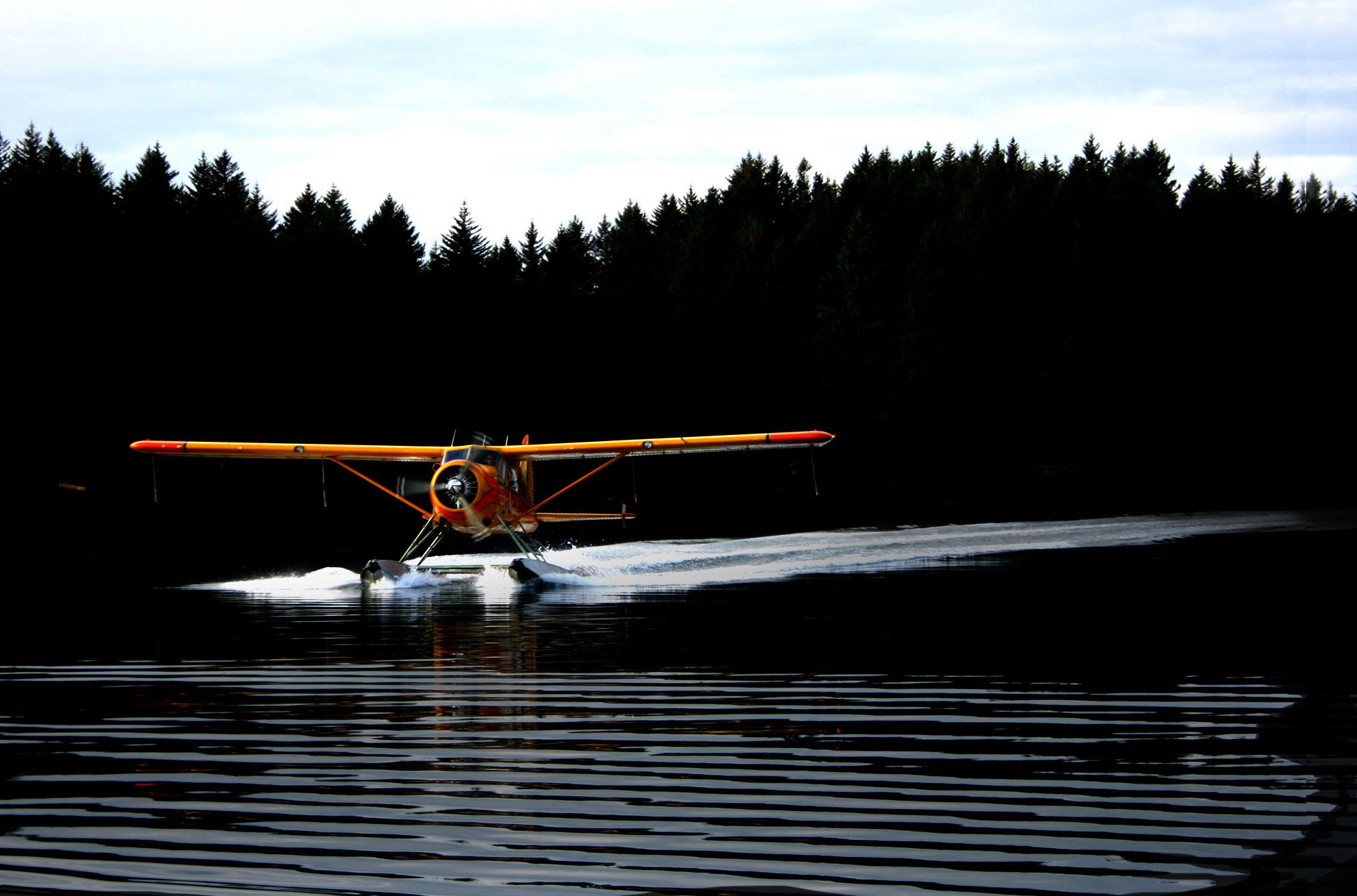
Canada
By Plane
Introduction
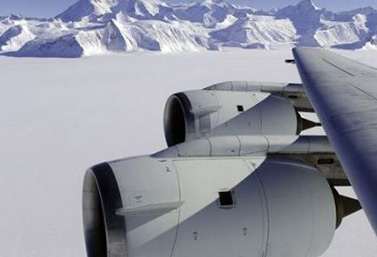
AFP/Michael Studinger
Thousands of airports
Canada has a highly developed airport network, with 1 594 certified airports, large and small. In addition, it is estimated that there are about 3,000 sites, sometimes only known to bush pilots, where it is risky but possible to land.
94% of all passengers and more than 97% of all cargo pass through the Canadian National Airports System, which comprises 27 major airports.
Toronto Pearson International Airport, Canada’s main airport, is one of only two in North America that serves destinations on all six inhabited continents.
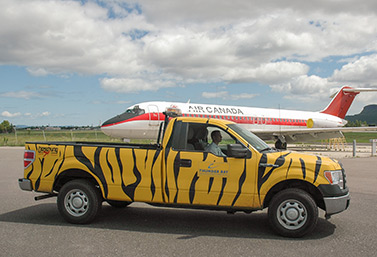
Located in Northern Ontario, Thunder Bay International Airport is one Canada’s 27 major airports.
(Canadian Press)Millions of passengers
In 1985, Canadian airports served 47 million passengers. In 2011, less than 20 years later, they welcomed 113 million passengers. In 2018, 155 million passengers passed through Canadian airports. These numbers may seem high, but in 2012 Canadians made only 5% of their important travel by plane.
When it comes travelling between two major Canadian cities, many people shun airplane travel, because of the relatively high cost of tickets. They prefer the comfort of their cars, even on rides 500 km to 1,000 km long.
Nearly a third of all planes coming to Canada land at Toronto Pearson International Airport. Air traffic is then redistributed across the country.
Traffic too concentrated in Toronto
Concentrating air traffic in Toronto may be beneficial for airlines. Canadian travellers, nevertheless, must often change planes to reach their destination. They often complain about the lack of direct flights, even between major cities.
Making the Canadian airport network profitable has always been a challenge. Canada is the second largest country in the world, but there are only 37 million Canadians, or 37 million potential passengers.
Limited airline competition
For more than 50 years, Canadians have been complaining about the shortcomings of the Canadian air transport network. With restricted competition, this situation is not about to change. Canadian travellers have very limited choice when it comes to flying within the country’s borders.
There are only two national carriers in the country, Air Canada and West Jet, and 50 small regional carriers. Also, despite airline deregulation in North America for the past 30 years, foreign companies’ access to Canadian territory is still limited.
All this translates into costly tickets, especially on flights to the Far North. In this sparsely populated region with few roads and no railways, people often have no choice but to travel by air.
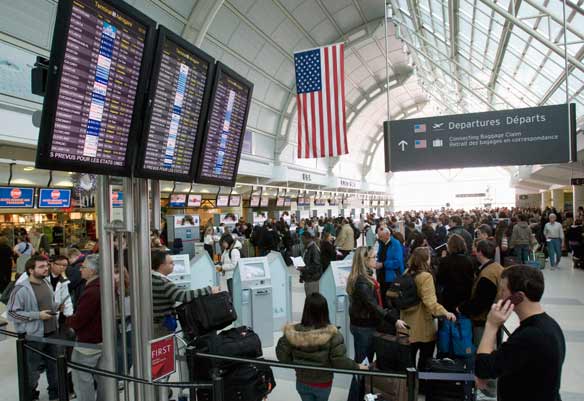
Passengers bound for the U.S. wait to go through customs at Toronto International Airport.
(Frank Gunn / Canadian Press)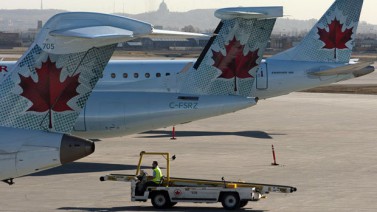
Air Canada planes wait at their assigned gates at Montreal International Airport, the third largest in Canada. Mount Royal’s silhouette can be seen in the background. (Ryan Remiorz / Canadian Press)
Did you know?
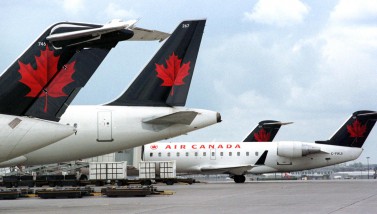
Air Canada is Canada’s largest airline.
(Thomas Cheng / AFP)Canada’s two major airlines
- Air Canada carried 61 million passengers in 2018, making it the 15th largest airline in the world.
- WestJet carried more than 25 million passengers in 2018, making it the ninth largest airline in North America in terms of passengers carried.
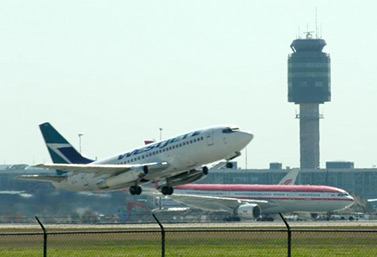
Vancouver airport, the second largest in Canada
(Kathryn Atkinson / AFP)By the numbers : the five largest airports in Canada
- Toronto International Airport – 33 million passengers
- Vancouver International Airport – 17 million passengers
- Montreal International Airport – 14 million passengers
- Calgary International Airport – 13 million passengers
- Edmonton International Airport – 6 million passengers
Read
Air passenger traffic at Canadian airports, annual – Statistics Canada
Watch
Takeoff of an Air Canada plane in Montreal
The air giant

PHOTO : LA PRESSE CANADIENNE / ANDRÉ FORGET
The airline and aerospace industries are very important parts of Canada’s economy.
They also have an important presence worldwide.
- Canada is the world’s fourth largest aircraft manufacturer, behind the United States, the United Kingdom and France.
- The Canadian airline industry is one of the world’s leading in terms of the services it provides to businesses.
- Landing gear manufacturing is the undisputed domain of Canadian companies. They provide this piece of equipment to the world’s largest commercial aircrafts, such as the Airbus A380 or the Boeing 787 Dreamliner.
- Canada is a leader in pilot training and aircraft maintenance.
- Canada is recognized as having one of the most comprehensive and safest civil aviation programs in the world.
A great story
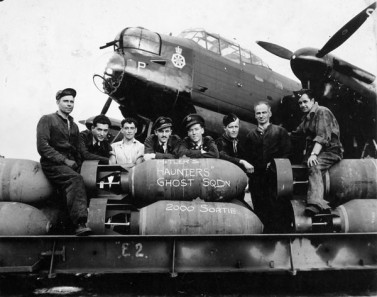
Canadian pilots in England prepare to take off for a mission over the city of Bremen, Germany on August 18 1944.
(Library and Archives Canada)Hundred years of expertise in flying
Canada’s expertise in aircraft construction dates back to World War I. Because of the pressing needs of war, the country made remarkable progress in that period, working closely with the United Kingdom.
By the end of 1918, Canada had produced 2,900 combat and training aircraft and about 30 seaplanes.
Between the World Wars, the country continued to develop its expertise and was ready when England called again for help, in 1939. Canada assembled 16,000 military aircraft. 10, 000 were sent to England; the rest were either used by the United States or remained in Canada to be used for pilot training.
Read
Canadian military aerospace industry in the two World Wars – Government of Canada (in French only)
Did you know?
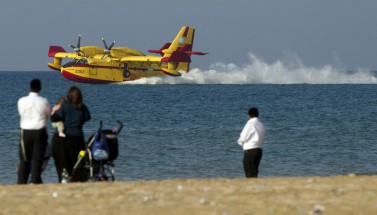
A tanker aircraft from Bombardier has its water supply replenished in the Mediterranean Sea, near the city of Haifa, Israel.
(Jack Guez / AFP)Top 4 Canadian civil aviation companies:
Air Canada: Founded in 1937 under the name of Trans-Canada Airlines, it ranks 15th among the biggest airlines in the world and 8th in terms of number of aircraft, with more than 400.
Pratt & Whitney Canada: It manufactures aircraft engines and high-performance helicopters. Its parent company is one of the three largest manufacturers of aircraft engines in the world, after General Electric, in the United States and Rolls-Royce, in England.
Canadair: This subsidiary of the Bombardier Aerospace was the first to produce an aircraft specifically designed to extinguish fires. In France, the word “Canadair” is synonymous with water air tanker.
CAE: The world leader in flight simulators in military and civil aviation, it trains more than 220,000 crew members each year, including more than 135,000 pilots, through its network of 27 centres.
Canada, control tower of the world
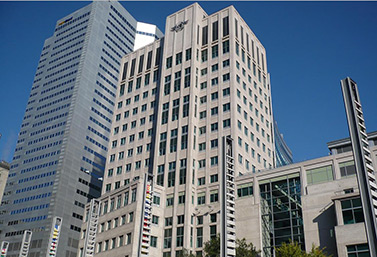
The Montreal-based International Civil Aviation Organization establishes rules and regulations that standardize aircraft transportation.
(Radio-Canada)Without Canada, airplane flying would be very dangerous, like trying to fly a plane with no rudder.
That’s because both the International Civil Aviation Organization (ICAO) and the International Air Transport Association (IATA) have their headquarters in Canada.
The International Civil Aviation Organization (ICAO) was created in 1947 in Montreal, in the province of Quebec. This UN agency issues the standards for air traffic and sharing of radio frequency and defines the protocols to be followed during the investigation of aviation accidents. It should not be confused with IATA, which is a private association of airlines, with its headquarters in Montreal.
The International Air Transport Association (IATA) is a private international trade organization that represents the interests of 290 airlines responsible for 82% of global passenger traffic. It simplifies transactions between airlines and travel agents. It also assigns three-letter codes for airports and two-letter codes for airlines.
Invented by Canadians!
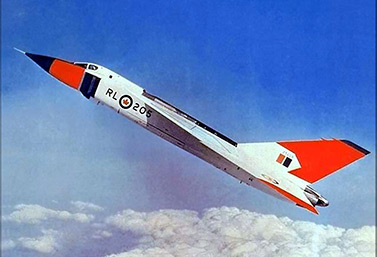
To counter the Soviet threat in the Far North in the 1950s, Canada created the most powerful fighter aircraft in the world. The CF-105 Avro Arrow could fly twice as fast as the speed of sound, 2,240 km/h, making it the fastest combat aircraft ever built.
(Government of Canada Archives)Canada developed one of the first passenger jets in the world
According to some, Canada’s important role in the world of civil and commercial aviation dates back to 1949. That year, the country developed a medium-haul passenger jet plane capable of flying at 800 mph, an incredible speed at the time. Manufactured by Avro Aircraft of Canada, it was called the Avro Jetliner.
The Avro Jetliner flew for the first time on August 10, 1949. Unfortunately, another jet had made its first flight just a few days earlier, in England.
A British jet beat the Canadian airliner to the starting line
The Avro Jetliner’s rival was the infamous British Comet, from the de Havilland Company. On July 27, 1949, only 13 days before the Avro, it flew for the first time, attracting the attention of the media and potential buyers. For a few years, the Comet would be the world’s first jetliner, until a series of catastrophic failures forced it to be withdrawn from service.
The destruction of the Avro Jetliner
The medium-haul Avro Jetliner seemed to be a perfect fit for the busy U.S. East Coast market. American billionaire Howard Hughes was so impressed with the Jetliner that he wanted to manufacture it in the U.S. Unfortunately, the Canadian government’s lack of interest the for the project lead to the end of production in 1951. The plane’s only existing prototype was destroyed, and only the word “jetliner” survived.
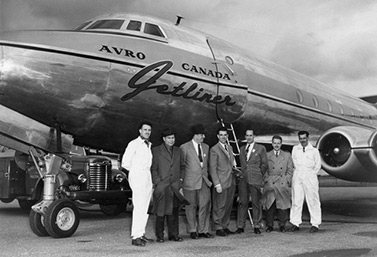
Here is a picture of the only prototype of the Avro Jetliner, in the early 1950s. In 1951, the federal government decided to stop the program and concentrate on the development of a military airplane, the Avro Canada CF-100.
(Museum of Aviation and Space in Canada)Watch
The Canadian aerospace industry.
Pioneers of the sky
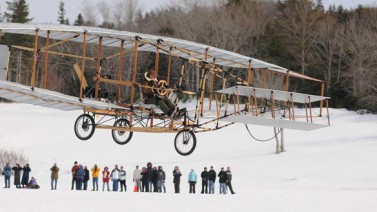
A replica of the Silver Dart soars into the sky on the day of the 100th anniversary of the first airplane flight in Canada. (CBC News)
Canadians were forerunners in the field of aviation and they took advantage of airplanes to travel long distances and across wilderness. In spite of that, passenger traffic in Canada has grown much slower than in Europe and the U.S.
In the late 1920s, it was technically possible to fly safely from coast-to-coast in less than 20 hours. Still, the country had no transnational airline. In 1928, the Canadian government decided to take the matter into its own hands. It assembled planes from regional carriers and created a new company called Trans-Canada Airlines (Air Canada).
Without the Canadian government’s initiative, scheduled passenger airline service would probably not have existed in Canada before the end of World War II.
Canada, late out of the gate
In the late 1920s, Canada’s airport infrastructure was lagging behind. The construction of a network of airports was urgent. A dozen cities were then targeted and offered subsidies. Furthermore, the Canadian government built a series of intermediate airfields at intervals of approximately 160 kilometers, for emergency landings. These airbases filled the gaps between the large municipal airports in the country.
In the late 1920s, the Canadian government decided to make the development of civil aviation a top priority. It was a way to bring Canadians together, and preserve and develop the country’s unity.
WWII and the development of Canadian Aviation
When WWII broke out, Canada realized that it had to build about 150 additional small military airports throughout the country, especially near the coasts. The government also decided to assume full financial responsibility for all municipal airports, a responsibility it assumed for more than 40 years.
For public safety, the federal government continues to this day to run a dozen airports in remote areas of the Arctic.
A great story
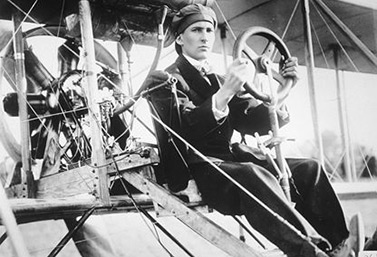
J.A.D. McCurdy flew the “Silver Dart” at Baddeck, Nova Scotia, 23 February 1909, the first flight of an aircraft in Canada
(City of Toronto Archives/SC244-79).Canadian pilot John McCurdy, first in his class
The first airplane flight in Canada is performed by John McCurdy in the province of Nova Scotia, in 1909. McCurdy flies a distance of half a mile on the Silver Dart, an aircraft he designed himself. This is the first British subject to fly an airplane. John McCurdy is also responsible for the construction of the first Canadian airport, in the city of Toronto, in 1915.
Invented in Canada!
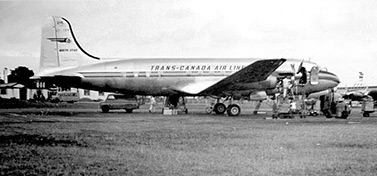
A DC-4 aircraft in the 1950’s. The plane sports the colors of Trans-Canada Airlines, Air Canada precursor.
(Museum of Aviation and Space in Canada)The transocenic aircraft
Canada is known around the world as the inventor of several famous types of innovative aircraft. At the end of World War II, one of these iconic airplanes stood out. The North Star was a large propeller model which allowed Canadian companies to finally inaugurate routes to Europe and Asia.
Manufactured by Canadair, a company created and managed by the government, it was in fact a pressurized version of the DC-4, one of the best American military transport aircraft of its time.
The North Star borrows some new airplane technology from the American-designed DC-6. Its long range is essential in the Canadian Arctic Territory. It is also reliable, but very noisy.
In 1951, a North Star airplane performs the first regular transoceanic link, Montreal-Paris. Subsequently, Sydney, Tokyo and Hong Kong open their skies to Canadian passengers.
Canada is known around the world as the inventor of several famous types of innovative aircraft. At the end of World War II, one of these iconic airplanes stood out. The North Star was a large propeller model which allowed Canadian companies to finally inaugurate routes to Europe and Asia.
Manufactured by Canadair, a company created and managed by the government, it was in fact a pressurized version of the DC-4, one of the best American military transport aircraft of its time.
The North Star borrows some new airplane technology from the American-designed DC-6. Its long range is essential in the Canadian Arctic Territory. It is also reliable, but very noisy.
In 1951, a North Star airplane performs the first regular transoceanic link, Montreal-Paris. Subsequently, Sydney, Tokyo and Hong Kong open their skies to Canadian passengers.
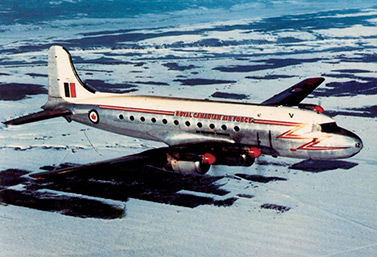
Aircraft Canadair DC-4M North Star in 1954, above Canada.
(Museum of Aviation and Space in Canada)Watch
Aboard a North Star, the first iconic Canadian plane.
Gander, a leading world airport
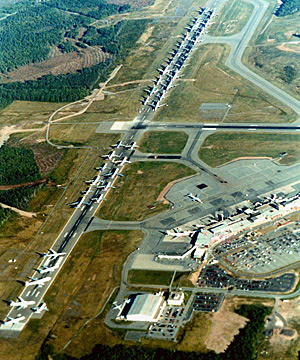
Aerial view of Gander Airport September 11, 2001. Parked on the runway are several aircraft that were supposed to land in the United States.
(Halifax International Airport Authority)Gander International, located on the island of Newfoundland, in Eastern Canada, has the distinction of being the world’s first largest airport. From 1940 to 1960, it was at the crossroads of the airways of the world.
At the time of the first transatlantic flights, in the mid-1930s, airplanes from Europe had to land in Newfoundland. Because of their low range, planes had to be refueled, before taking off again to take their passengers to Boston or New York.
“If you build it, they will come”
In 1936, in this secluded and sparsely populated area of Canada, a team of workers began to build the main runway, a few meters from the rugged coast, lashed by the winds. Gander was chosen because of its strategic position at the epicentre of the Great Circle Route between Europe and the Americas.
In 1940, two years after its opening, Gander was the largest airport in the world.
Gander Goes to War
Gander Airport’s four paved runways put it at the forefront of air traffic throughout World War II. It was the main point of departure to Europe for thousands of military aircraft built in North America. Gander became one of Canada’s most important military bases. Throughout the war, at least 10,000 Canadian, American and British soldiers were permanently stationed there.
The airport was widely used as a stopover site for anti-submarine air patrols dedicated to hunting German U-boats in the Northwest Atlantic.
The Royal Canadian Navy also developed a radio surveillance station at the airport, using it as a listening post and to detect transmissions and movement of submarines or enemy ships.
The ultimate airport
After the armed conflict of 1939-1945, the international role of Gander Airport was expanded. During the Cold War, military installations were improved. Large civilian airlines, including Trans-Canada Airlines, began to offer regular transatlantic passenger service, and all these flights stopped at Gander.
During the 1950s, Gander was one of the busiest international airports worldwide. It was nicknamed “the crossroads of the world.
Emergency alternate airport
With the arrival of long-range jet aircraft, traffic in the skies of Gander has become less dense, but the airport continues to play an important role.
Gander Control is one of two air traffic control centres that manage the North Atlantic routes, the other one being Shanwick Oceanic Control, in Ireland. Each aircraft travelling to Europe or North America has to contact one of these centers. A quarter of a million flights cross the Atlantic each year, and pilots must encircle in red the name Gander on their navigation maps, in case something goes wrong.
A “lifeboat” on September 11, 2001
Gander airport became the “lifeboat” of international civil aviation in the North Atlantic during the terrorist attacks of September 11, 2001.
That day, after the airspace of the United States was closed, Gander hosted 39 flights in two hours and kept them on the ground at least 24 hours. In doing so, the airport received 6,122 passengers and 473 crew members.
At the same time, on the West Coast of Canada, Vancouver airport, also built in the late 1930s, welcomed passengers and 8,500 crew members flying from Asia to the United-States.
More recently, Gander’s runway 03/21 held the role of emergency runway for the Space Shuttle.
Read
‘I’ll never forget’: Gander remembers 9/11, 15 years later – CBC
How a little piece of Gander ended up at 9/11 Memorial Museum – CBC
“Come From Away”: out of the 9/11 tragedy a rousing musical tale of kindness – RCI
Watch
Landing at the airport in Gander.
For discerning travellers
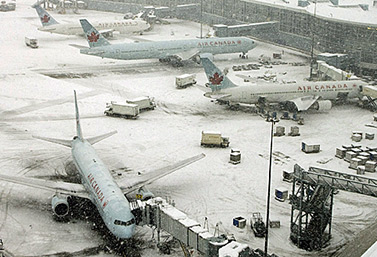
Air Canada planes, covered with snow, waiting for the signal to board their passengers in Toronto.
(Richard Lam / Canadian Press)Planes shorten distances in the world’s second largest country. They are especially important in the North, where there are no roads to connect about 60 villages and 120 000 inhabitants year-round. But, if the airplane is king in Northern Canada, it is not always cheap. In the region, airports can be snow-covered nine or ten months a year.
There are several things that you should know before you venture into Canada’s Northern Airspace.
In the Far North, be on time for takeoffs
About 40% of Canada is in what is called the North, or land that is located north of the 60th parallel. At this latitude, you are still more than 3,000 kilometers from the North Pole!
In this vast region, two Inuit-owned airlines run on a regular basis: Air Inuit and First Air. They offer weekly flights to Nunavik for example, a region that comprises the northern third of the province of Quebec.
Be at the airport on time, otherwise you will have to wait up to a week to embark on the next flight!
Tickets that are worth their weight in gold
Canadians have always complained that flying is very expensive in Canada. They eye price discounts offered in the U.S. with envy.In Canada, tickets are much more expensive than in Europe or the United States, even on busy routes. For example, a return trip Montreal-Yellowknife or Toronto-Yellowknife (the busiest flights in northern Canada) costs 1000 euros, or more than 1500 Canadian dollars per person.
Air monopolies
In Canada, there are only two truly national carriers that control nearly 80% of the market, Air Canada and WestJet. That limits competition and increases ticket prices. It is estimated that 10% of Canadian travellers choose to travel by car to an American airport near the U.S. border, to take advantage of international flights at the best price.According to a study by the Hotel Association of Canada published in 2013, close to one in five Canadian travellers go to the United States to take a flight.
In 2011, five million Canadian travellers preferred to take a cheaper flight from a U.S. airport. Consequently, the number of people who fly from Canada is down by about 10 %. According to Air Canada, this is another key reason why ticket prices are higher in Canada than in the United States.
Too many taxes
Another factor that explains the high price of tickets is the multiplication of taxes of all kinds, which have increased considerably since airports reverted to private interests 20 years ago.- According to Statistics Canada, the average cost of air travel in Canada in 2017 was $232.50, excluding taxes and “user fees” such as airport improvement fees or fuel costs. This is 60% more than the same ticket purchased in the United States.
- The Canadian Airports Council says that departures for round-trip flights from Canada are between 50 to 100% more expensive on average than departures from the U.S.
- Air Canada considers that landing, airport improvement, navigation and safety fees are 229% higher in Canada than they are in the United States.
Did you know?
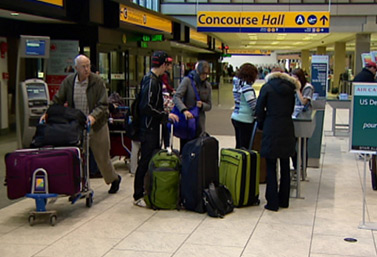
It`s a busy day for several passengers at the Calgary International Airport, Alberta.
(Canadian Broadcasting Corporation)Before buying a ticket, make sure you know the real price!
Up until recently in Canada, customers could not rely on the price of a ticket advertised by many airlines. The final cost could be double! And even to this day, you’d better verify before you buy.
“One hundred dollars to fly from Montreal to Toronto!”
This newspaper advertisement seems like a bargain. But when you read what is written in small letters at the bottom of the page, the price of airfare increases rapidly.
- First, you have to pay the airline $ 20 for “air traffic control services.”
- Then you must add $ 24 for “airport security”.
- You should also add charges for “improving airport infrastructure.” In Montreal, the fee is $ 15 per passenger.
- The airline claims an extra $ 3 for “the rising cost of flight insurance”.
- Finally, $ 7.50 will be added to your invoice to cover “increase in fuel prices.”
- Total advertised price: $ 69.50.
- Final airfare: $ 169.50
In 2012, Canadian justice intervened in favor of travellers: prices advertised in Canada must be “all-inclusive”.
But, in spite of the court decision, fine print still appears at the bottom of advertisements. Indeed, “all inclusive” does not necessarily include fees for optional services, such as in-flight entertainment ($ 8), headphones ($ 5), lunch ($ 10), drinks (5 $) and baggage fees ($ 20).
When you add all these amounts to the base price of your Montreal-Toronto ticket ($ 100), the bill jumps to about $ 217.
Bon voyage in Canadian skies!
Bush Flying
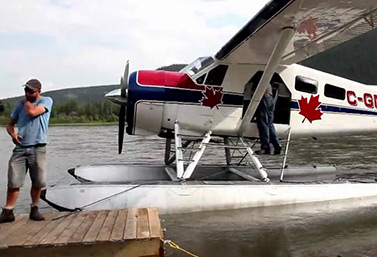
A classic Canadian bush plane in the Northwest Territories
(Canadian Broadcasting Corporation)If ever you go to Yellowknife, capital of the Northwest Territories, you should visit one of the most famous tourist sites in the area, the Bush Pilot’s Monument. It is a short walk from the airport and stands on the highest rock in the small city of 15,000 people.
The Bush Pilot’s Monument was erected to honor all those who sacrificed their lives to open up the North. More than a hundred pilots have died or went missing during nearly 90 years of bush flying.
Long before the era of the 747 and the Airbus A300, bush pilots had to make do with the means at hand and adapt to the bitter cold of Arctic winter.
Even today, bush pilot gives Canadian aviation its particular style.
“A bush pilot symbolizes what it means to be a Canadian. Pushed, thrashed and whipped by the winds of winter, blinded by snow that hisses at him, his wings weighed down by ice, he manages the impossible almost every time … “
Lost between heaven and ice
Bush pilots exercise one of the most dangerous occupations there is.
In 1920-1930, their flights took place in precarious conditions. Planes were not built to withstand extreme cold and often fell down near their base.
Pilots flew in freezing temperatures in cockpits often open to the elements, without navigational aids and radio, landing fields and beacons or hangars for repairs.
READ
A great story
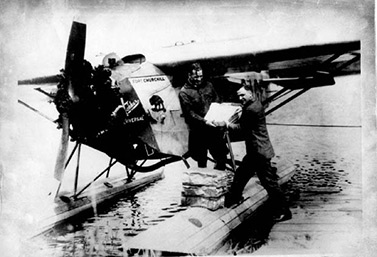
An pilot gives a letter to his colleague, Fred Stevenson, in 1927.
(Archives of the Winnipeg International Airport)The greatest Canadian aviator of all time
The first journey of a bush pilot in the Canadian Arctic dates back to 1927, when Frederick Stevenson, a former military pilot from World War I, made 27 trips in 30 days in March and April 1927. A few business people from Winnipeg, in the province of Manitoba, had hired him for their new airline. The first contract was a series of flights between Cache Lake and Fort Churchill, two small towns separated by 200 km.
Stevenson travelled more than 10,000 kilometers to carry 7,000 kg of equipment and 14 men who were to start exploratory drilling in the summer in the coastal town of Churchill. This was the first major airlift in Canada.
A second operation took place from August to October 1927. Stevenson crossed over 20,000 miles in 28 days and carried 23 tons of mining equipment. Never had such a large volume of goods been flown in North America.
On January 5, 1928, Frederick Stevenson tested his Fokker plane at the Winnipeg airport. The plane had been repaired. The takeoff was perfect, but because of a pilot error, the plane crashed at landing. Stevenson died instantly.
Watch
The de Havilland Beaver float plane.
Watch
Landing a bush plane in Canada.
The Classic Canadian Bush Plane – Northwest Territories, Canada.
The de Havilland Canada Beaver.
The legacy of Frederick Stevenson
At the end of World War I, most Canadians believed that the act of flying was reserved to military activity a trivial pastime
Stevenson’s shipments contributed to prove that planes could be used in peacetime and in remote areas.
Moreover, these expeditions showed the mining industry that sending equipment by air was cheaper than transporting it by land in the tundra.
Since the exploits of Stevenson, planes have allowed government surveyors to draw maps of areas of land and water in seemingly endless northern territories. They have also helped pulp and paper manufacturers to identify their forest reserves and mining companies to take prospectors to very isolated places.
Invented by Canadians!
The short takeoff aircraft
Canada developed short takeoff and landing aircraft that are now found all over the world. Adapting to the needs of a northern country, the Canadian aircraft industry focused on the issue of short landings and takeoffs in the bush. In 1947, de Havilland of Canada hired a highly regarded Canadian pilot, Punch Dickins, to help design the ideal bush plane: an all-metal aircraft, with a high power-to-weight ratio, capable of loading large cargo. Thus was born the Beaver.
Other small Canadian planes came after the Beaver: the Otter, the Twin Otter, the Caribou, the Buffalo and more recently, the famous Dash 7.
The design and construction of short takeoff and landing planes (STOLs) is another trademark of the Canadian Aerospace Industry’s worldwide reputation.
Canadian aircrafts go around the world
STOLs have opened up wilderness areas around the world, including deserts, mountains, jungles or tundra.
Another famous Canadian airplane is the Canadair CL-215, an amphibious aircraft which showed its value fighting fires in many countries.Did you know?
A bush plane operating in rough terrain is equipped with tundra tires, floats or skis.
Its wings are set above the fuselage to cut the risk of touching the ground. Vegetation, snow, ice, rocks and waves are obstacles that must be taken into account.
This type of plane lands at an angle on its back, the front propeller held up high over the terrain, so that the pilot can avoid rocks, tree trunks and other debris.
Discover
Photo album